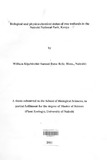| dc.description.abstract | A wetland is an area of land whose soil is saturated with moisture either
permanently or seasonally. Such areas may also be covered partially or
completely by shallow pools of water. Wetlands include swamps, marshes, and
bogs, among others. Wetlands differ in their soils, landscapes, microclimates,
water regimes and chemistry, vegetation types, and human disturbances.
Chemical composition of wetlands varies depending on their location, substrate
chemistry, the amount of water present in them and human impacts. These
variations have corresponding impacts on the aquatic biota of the ecosystems.
Challenges facing the ecological integrity of wetland ecosystems vary but are
mostly affected by over exploitation, changes in water quality, eutrophication,
organic loading, invasive species, and hydrographic changes in aquatic systems.
These challenges can be traced to changes in land use patterns or anthropogenic
activities, waste disposal, and diversions or impoundments of water bodies
feeding these systems. Two wetlands (Hyena and Nalogomon dams) in the
Nairobi National Park were studied. These wetlands are important providers of
ecosystem goods and services such as drinking water and dry season grazing
habitat for wild game in the park. The main objective of this study was to
determine the environmental status of the two wetlands by comparing their
physico-chemical properties of their water and soil/sediment; and to document the
plant species diversity of their immediate environments. Four points were selected
randomly in each dam site. Three samples of both water and soil were collected
from each point and taken to the lab for analysis.
There were significant (p< 0.05) differences in phosphorus, magnesium, copper
and sulphates in soil/sediment between Hyena and Nalogomon study sites.
Soils/sediment at Hyena had the highest levels of heavy metals, especially copper
(4.73 ± 0.05 mg/kg) , compared to Nalogomon. Likewise, there were differences
in water parameters, namely manganese and sulphates were found to be
significantly (p < 0.05) higher at Hyena than at Nalogomon. Plant tissues at
Hyena Dam were found to have higher levels of iron (0.63 ± 0.12 mg/kg)
compared to those of Nalogomon (0.47 ± 0.09 mg/kg). The most common plant
species at Hyena was Cyperus dives while at Nalogomon were Typha
domingensis and Hyparrhemia rufa. Generally it was concluded that Hyena had
more pollutants due to human effects compared to Nalogomon. This shows that
conservation measures should be taken to control pollution of wetlands in Nairobi
National park especially the pollution coming from the human estates nearby. | en |

